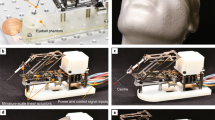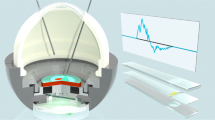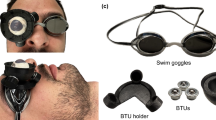Abstract
Purpose
To test the feasibility of retinal manipulations using a new micromanipulator (Microhand) for ocular robotic microsurgery.
Methods
Pneumatically actuated four-finger microhands were developed at UCLA with micro electromechanical systems (MEMS) technology to mimic a human hand for small object manipulation. Microhands with four 4 mm finger lengths were used for this study to lift caliper weights and fresh retinal tissue of porcine cadaver eyes to find the maximum force at a given pressure and feasibility of the microhands for retinal manipulation in real surgery.
Results
A full closure of the microhand used for caliper weight lifting was achieved under 65 psi (448 kPa) of air pressure. The four-fingered microhand was able to develop about 20 mN of total lifting force and 5 mN per finger at 80 psi (551 kPa), and was strong enough to displace and lift the retina of pig eyes.
Conclusions
The microhand is able to apply calibrated forces to ocular tissues and is suitable for ocular microsurgical procedures. This new tool would be useful in the development of robotic microsurgery.
Similar content being viewed by others
Introduction
More than 850 robotic systems are currently in use for laparoscopic procedures in abdominal, urologic, pelvic, cardiothoracic, and neurologic surgery,1, 2, 3, 4, 5, 6, 7, 8 showing a broad spectrum of advantages. Worldwide, more than 20 000 robotic surgical procedures have been performed each year since 2004.2, 4 Encouraging developments have stemmed from recent studies on ocular robotic surgery.9, 10 For ocular microsurgery, dedicated surgical instruments have to be specifically adapted for ocular robotic tasks, and the force applied by the robot on ocular tissues should be well quantified and controlled to avoid unexpected ocular damage. Although forces applied during retinal microsurgery have already been estimated,11, 12 no dedicated microsurgical forceps have been designed so far allowing calibrated forces to be reliably applied to tissues during ocular surgery. In this study, we evaluated the use of a new microhand for robotic microsurgery on porcine cadaver eyes,13 and were able to apply an appropriate strength of closure to manipulate a porcine retinal membrane.
Materials and methods
The Microhand
A pneumatically operated micromanipulator (‘Microhand’) consisting of balloon-based active joints and interconnecting silicon phalanges was developed at UCLA.12 With the introduction of compressed air, the balloon joints inflate and the attached silicon phalanges make relative out-of-plane motion as a result, as shown in Figure 1. Parylene, which is biocompatible and chronically stable, was used as a balloon material for biological applications. Microhands with various designs were fabricated for testing. The microhand used for retina-pulling experiments had four 4 mm-long and 800 μm-wide fingers with 6 μm-thick balloons. Each finger was a system of six phalanges and six balloons, the latter being made of 3 μm-thick parylene membranes (Figure 2). The pressure of the compressed air changed the inflation level of the parylene balloons to make a required curling shape and exert a force that mimics the action of a human finger on a millimeter scale (Figure 3).
Sideview of the operation of microhand, showing two opposing microfingers. A microfinger is articulated by six silicon phalanges (a, white arrow) and joined by inflatable balloons (a, arrowheads). When the balloons inflate (b, red arrowhead), the fingers are incurved (a, grey arrows and b) and face themselves along the central axis (grey line).
Fabrication process of the microhand mainly consisted of four photolithography steps. Each step involved directional (anisotropic) or undirectional (isotropic) silicon etching using various drying etching methods, such as DRIE (deep-reactive ion etching) and XeF2 gas etching. Parylene was uniformly deposited in the silicon cavities used as a mold for balloon, and patterned by subsequent O2 plasma etching to form active pneumatic balloon joints. The balloon joint-phalange system was completed by release etching with XeF2 gas.
The microhand device was then bonded to a separately machined Plexiglas cube that connected the air inlet hole on the fabricated microhand chip to the tube with a nitrogen tank attached to the other end.
The five balloons (ie, joints) in each finger are connected serially, as well as the fingers themselves. However, unlike the common manufacturing methods, which involve assembly of parts, the microhand is fabricated ‘monolithically’, which means the probability of one of the five or all twenty joints failing is virtually as low as just one joint failing.
A leakage in one of the balloons makes the whole forceps not functional. So, the surgeon is immediately aware that the forceps should not be used anymore and can act accordingly.
Evaluation of the forces sustained by the microhand
The microhand device evaluated in our study was fabricated to achieve a large lifting force. At 65 psi (448 kPa), the microhand showed a full closure (Figure 3). Microhand's lifting forces were measured by using coil-shaped metallic weights of known mass. The microhand was operated to lift the upper part of the weight, and was lifted up by a stage until it was hanging and a steady state was obtained. The procedure was repeated three times for each weight (0.25 g, 0.5 g, and 1 g). Air pressure up to 110 psi (758 kPa) was used for this test.
Experiments using porcine cadaver eyes to approach surgical conditions were performed to assess the feasibility of the microhand for retinal surgery. A total of 10 pig eyes were used for the ex vivo experimentation. We certify that all applicable institutional and governmental regulations concerning the ethical use of animals were followed during this research. As the prototype of the microhand was not yet allowing any penetration through a corneal or sclera wound, the posterior pole was flat-mounted. The microhand mounted on an XYZ stage was translated to the neuro-retinal surface of the macular area and actuated by applying the air pressure required for full closure of the microhand until some neuro-retina was entrapped between the microhand's fingers. The microhand holding the retina was then raised vertically. The experiments were rated ‘passed’ if the retina could be limited 2 mm in height or displaced 2mm away and hanging steadily, and ‘failed’ if the microhand did not permanently grasp, hang and lift the retina. Five measurements were performed for each test.
Results
A pressure of 80 psi was applied to the microhand to have a single finger lift up to 0.5 g weight (about 5 mN equivalent) in the air (Figure 4a and b). The finger did not lose the metal weight even after decreasing the pressure to 60 psi (413 kPa). All the four fingers were used to lift up and hold a 1 g (about 10 mN equivalent) weight at 80 psi (551 kPa) with no subsequent damage to the fingers (Figure 4b and d).
Evaluation of the microhand for lifting and displacing the neuro-retina (out of the RPE) of flat-mounted pig eyes showed that different level of air pressure insufflated in the forceps was required for each step. A 65 psi (448 kPa) air pressure was necessary to pinch the retina (Figure 5). The force applied for this operation was estimated to be less than 5 mN. At 60 psi (413 kPa), the microhand passed 5/5 retina entrapment tests and 4/5 vertical retina displacement tests. The last vertical displacement test failed because the microhand did not maintain a permanent grasping of the successfully lifted retina. However, no retinal tear was obtained because the retinal tissue grasped slipped out of the microhand's fingers.
Discussion
The microhand is a forceps prototype for micromanipulation fabricated by micro electromechanical systems (MEMS) technology. Its object manipulation mimics that of a human hand. The microhand in this study successfully showed the lifting of retinal membrane on a porcine eye's flat-mounted posterior pole, and showed that they can generate enough force for retinal manipulation by design customization. Its ability for precise force control and gentle manipulation on irregularly shaped objects match surgeon's need for intraocular microsurgery tools. The forces required during the retinal surgery on porcine cadaver eyes have been reported to be less than 7.5 mN during 75% of the event of manipulation with a maximum of 30 mN reached when the normal retina was lifted.11, 12 The test result with the microhand shows that it can exert enough lifting force to manipulate the retinal membrane most of time. With 5 mN force to each finger, about 20 mN of total force may theoretically be generated by using four fingers together.
The motion of the microfingers is controlled by adjusting the applied air pressure to inflate the microhand's balloon joints to achieve a required grabbing force, without any direct human hand intervention during the microfingers operation. In addition to the visual feedback used to gauge tissue manipulation in regular intraocular surgery, the microhand could theoretically control the risk of iatrogenic lesions by controlling the calibration of the force applied.
Another advantage of this pneumatic forceps is that it can use conventional pressure controllers that are currently in use for retinal surgical tools, such as a vitreous cutter. The use of pneumatic actuation is technically simplifying the surgical system without requiring additional operating setup.
At high pressure (80 psi, 551 kPa), two opposite fingers are bending inside (Figure 4b and d). This microhand's prototype was designed to fully close at 65 psi (448 kPa) allowing the retina to be properly grasped (as shown in Figure 3). Moreover, the microhand designs can be customized to satisfy various surgical requirements. Conventional forceps, for instance, designed for ocular microsurgery usually have a single point of grasping, but microhands can be designed to have multiple points of grasping with various grasping shapes for larger grabbing areas. By having multiple grabbing points, the delivered forces can be more homogeneously distributed on tissues (pre-retinal membrane, PVR, new-vessels) and reduce the focal iatrogenic traction applied on ocular tissues that could be observed when a conventional single point forceps is used. In addition, the size of the microhand and the number of microfingers can be changed by design to perform required surgical tasks.
In addition, the microhand's ball-shaped closure enables an entrapment of objects. This is very useful when smooth and large objects such as tilted lens fragments need to be manipulated, or foreign bodies in the eye need to be removed.
The microhand's advantages add to the existing microsurgery instruments and are of special interest in the development of robotic ocular surgery. The first test results are encouraging for the use of the microhand for ocular surgery as well as for quantifying the forces required during the surgery.
References
Fleck T, Tschernko E, Hutschala D, Simon-Kupilik N, Bader T, Wolner E et al. Total endoscopic CABG using robotics on beating heart. Heart Surg Forum 2005; 8: E266–E268.
Kumar R, Hemal A . Emerging role of robotics in urology. J Min Access Surg 2005; 202–210.
Frede T, Jaspers J, Hammady A, Lesch J, Teber D, Rassweiler J . Robotics and tele-manipulation: update and perspectives in urology. Minerva Urol Nefrol 2007; 59: 179–189.
Kumar S, Marescaux J . Telesurgery, Vol. 1, 1st edn Springer-Verlag: Berlin, Heidelberg, New York, 2008.
Rentschler ME, Platt SR, Dumpert J, Farritor SM, Oleynikov D . In vivo laparoscopic robotics. Int J Surg 2006; 4: 167–171.
Thiel DD, Winfield HN . Robotics in urology: past, present, and future. J Endourol 2008; 22: 825–830.
Herron DM, Marohn M . A consensus document on robotic surgery. Surg Endosc 2008; 22: 313–325.
Intuitive Surgical C. The da Vinci System: http://www.intuitivesurgical.com/corporate/index.aspx, v 2008.
Tsirbas A, Mango C, Dutson E . Robotic ocular surgery. Br J Ophthalmol 2007; 91: 18–21.
Yu DY, Cringle SJ, Constable IJ . Robotic ocular ultramicrosurgery. Aust N Z J Ophthalmol 1998; 26 (Suppl 1): S6–S8.
Gupta P, Jensen P, de Juan E . Surgical forces and tactile perception during retinal microsurgery. In: Taylor C, Colchester A. (eds). Medical Image Computing and Computer-Assisted Intervention-MICCAI′99. Springer-Verlag: Berlin, Heidelberg, 1999, pp 1218–1225.
Jagtap AS, Riviere CN . Applied force during vitreoretinal microsurgery with handheld instruments. Conf Proc IEEE Eng Med Biol Soc 2004; 4: 2771–2773.
Lu Y, Kim C . Microhand for biological applications. Appl Phys Lett 2006; 89: 1641011–1641013.
Acknowledgements
This study has been presented earlier in part (poster 5958/A423) at the 2008 ARVO annual meeting in Fort Lauderdale, FL, USA.
Author information
Authors and Affiliations
Corresponding author
Rights and permissions
About this article
Cite this article
Hubschman, JP., Bourges, JL., Choi, W. et al. ‘The Microhand’: a new concept of micro-forceps for ocular robotic surgery. Eye 24, 364–367 (2010). https://doi.org/10.1038/eye.2009.47
Received:
Revised:
Accepted:
Published:
Issue Date:
DOI: https://doi.org/10.1038/eye.2009.47
Keywords
This article is cited by
-
Robotics and cybersurgery in ophthalmology: a current perspective
Journal of Robotic Surgery (2023)
-
Preliminary study of an RNN-based active interventional robotic system (AIRS) in retinal microsurgery
International Journal of Computer Assisted Radiology and Surgery (2019)
-
Research and Realization of a Master-Slave Robotic System for Retinal Vascular Bypass Surgery
Chinese Journal of Mechanical Engineering (2018)
-
Microrobotic tentacles with spiral bending capability based on shape-engineered elastomeric microtubes
Scientific Reports (2015)
-
Robot-assisted intraocular surgery: development of the IRISS and feasibility studies in an animal model
Eye (2013)








